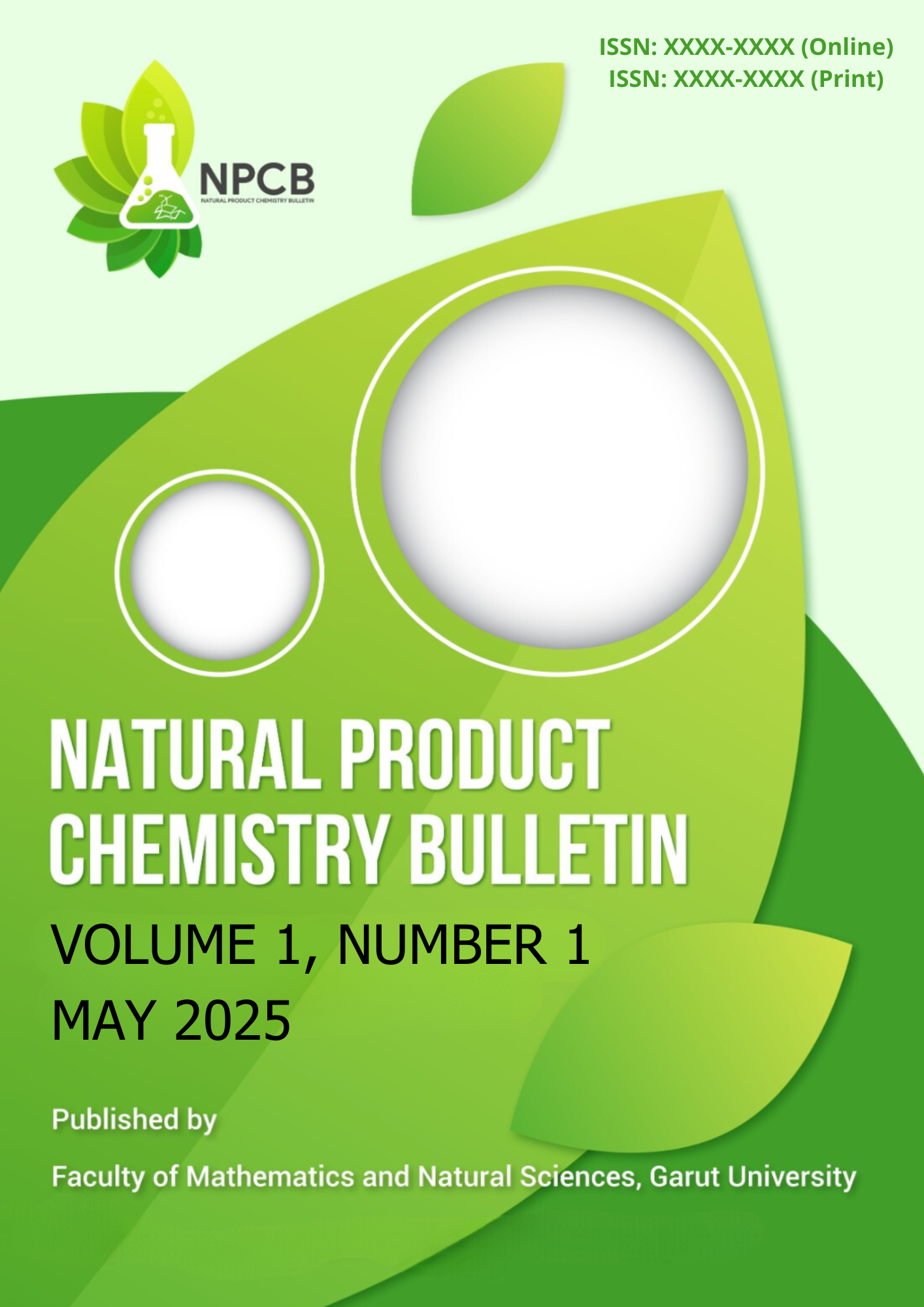Isolasi dan Karakterisasi Selulosa Bakteri dari Limbah Kulit Jeruk Peras (Citrus sinensis L. Osbeck)
DOI:
https://doi.org/10.52434/npcb.v1i1.42503Keywords:
fermentasi, kulit jeruk peras, selulosa bakteriAbstract
Selulosa bakteri merupakan salah satu biopolimer yang diproduksi oleh berbagai jenis bakteri, termasuk Gluconacetobacter xylinus. Dibandingkan dengan selulosa tanaman, selulosa bakteri memiliki keunggulan seperti biokompatibilitas tinggi dan daya serap air yang besar. Namun, produksi selulosa bakteri masih terkendala biaya tinggi akibat penggunaan media Hestrin–Schramm (HS) yang mahal. Untuk mengatasi hal tersebut, penelitian ini mengevaluasi potensi limbah kulit jeruk peras sebagai media alternatif pertumbuhan G. xylinus. Penelitian dilakukan dengan melakukan beberapa variasi parameter fermentasi, meliputi pH, jumlah inokulum, konsentrasi substrat, dan waktu fermentasi. Selulosa bakteri yang dihasilkan dianalisis menggunakan spektrofotometer Fourier Transform Infrared (FTIR) untuk mengidentifikasi gugus fungsional. Hasil menunjukkan bahwa kondisi optimum diperoleh pada pH 5, jumlah inokulum 15%, konsentrasi substrat 15%, dan waktu fermentasi 10 hari. Analisis FTIR mengidentifikasi adanya gugus O–H pada bilangan gelombang 3271,04 cm⁻¹ dan gugus C–O–C glikosida pada 1107,01 cm⁻¹, yang merupakan ciri khas selulosa. Hasil ini membuktikan bahwa limbah kulit jeruk berpotensi sebagai media alternatif yang efektif untuk produksi selulosa bakteri.
References
Coseri, Sergiu. 2021. “Insights on Cellulose Research in the Last Two Decades in Romania.” Polymers 13(5):1–19. doi: 10.3390/polym13050689.
Indriyati, Yuyun Irmawati, and Tita Puspitasari. 2019. “Comparative Study of Bacterial Cellulose Film Dried Using Microwave and Air Convection Heating.” Journal of Engineering and Technological Sciences 51(1):121–32. doi: 10.5614/j.eng.technol.sci.2019.51.1.8.
Kusumaningati, MA, S. Nurhatika, and A. Muhibuddin. 2013. “Pengaruh Konsentrasi Inokulum Bakteri Zymomonas Mobilis Dan Lama Fermentasi Pada Produksi Etanol Dari Sampah Sayur Dan Buah Pasar Wonokromo Surabaya.” Jurnal Sains Dan Seni ITS 2(2):218–223.
Oikeh, Ehigbai I., Faith E. Oviasogie, and Ehimwenma S. Omoregie. 2020. “Quantitative Phytochemical Analysis and Antimicrobial Activities of Fresh and Dry Ethanol Extracts of Citrus Sinensis (L.) Osbeck (Sweet Orange) Peels.” Clinical Phytoscience 6(1). doi: 10.1186/s40816-020-00193-w.
Putri, Sherly Novia Yuana, Wahyu Fajri Syaharani, Cindy Virgiani Budi Utami, Dyah Retno Safitri, Zahra Nur Arum, Zulfa Shafira Prihastari, and Anjar Ruspita Sari. 2021. “Pengaruh Mikroorganisme, Bahan Baku, Dan Waktu Inkubasi Pada Karakter Nata: Review.” Jurnal Teknologi Hasil Pertanian 14(1):62. doi: 10.20961/jthp.v14i1.47654.
Rahman, Sameeha Syed Abdul, T. Vaishnavi, G. Sai Vidyasri, K. Sathya, P. Priyanka, Ponnusami Venkatachalam, and Sugumaran Karuppiah. 2021. “Production of Bacterial Cellulose Using Gluconacetobacter Kombuchae Immobilized on Luffa Aegyptiaca Support.” Scientific Reports 11(1):1–15. doi: 10.1038/s41598-021-82596-4.
Seddiqi, Hadi, Erfan Oliaei, Hengameh Honarkar, Jianfeng Jin, Lester C. Geonzon, Rommel G. Bacabac, and Jenneke Klein-Nulend. 2021. “Cellulose and Its Derivatives: Towards Biomedical Applications.” Cellulose 28(4). doi: 10.1007/s10570-020-03674-w.
Singh, Omchand, Parmjit S. Panesar, and Harish K. Chopra. 2017. “Isolation and Characterization of Cellulose Producing Bacterial Isolate from Rotten Grapes.” Biosciences, Biotechnology Research Asia 14(1):373–380. doi: 10.13005/bbra/2455.
Suripto, Udiantoro S. P, and Lya Agustina. 2018. “Identifikasi Mutu Pasca Panen Nata De Coco Berdasarkan Lama Perendaman Dan Perebusan.” Inovasi Agroindustri 1(1):29–37.
Ting, S. V., and E. J. Deszyck. 1961. “The Carbohydrates in the Peel of Oranges and Grapefruit.” Journal of Food Science 26(2):146–152. doi: 10.1111/j.1365-2621.1961.tb00784.x.
Torrado, Ana María, Sandra Cortés, José Manuel Salgado, Belén Max, Noelia Rodríguez, Belinda P. Bibbins, Attilio Converti, and José Manuel Domínguez. 2011. “Citric Acid Production from Orange Peel Wastes by Solid-State Fermentation.” Brazilian Journal of Microbiology 42(1):394–409. doi: 10.1590/S1517-83822011000100049.
Downloads
Published
Issue
Section
License
or all articles published in Natural Product Chemistry Bulletin, the copyright is retained by the journal. Articles are published under the terms of Creative Commons Attribution-ShareAlike 4.0 International License (CC-BY-SA 4.0) .
For Authors:
- Any article on the copyright is retained by the author(s).
- The author grants the journal, right of first publication with the work simultaneously licensed under a Creative Commons Attribution License that allows others to share work with an acknowledgment of the work authors and initial publications in this journal.
- Authors are able to enter into separate, additional contractual arrangements for the non-exclusive distribution of published articles of work (eg, post-institutional repository) or publish it in a book, with acknowledgment of its initial publication in this journal.
- Authors are permitted and encouraged to post their work online (e.g., in institutional repositories or on their websites) prior to and during the submission process, as can lead to productive exchanges, as well as earlier and greater citation of published work.
- The article and any associated published material is distributed under the Creative Commons Attribution-ShareAlike 4.0 International License


1.png) Download Journal Template
Download Journal Template








